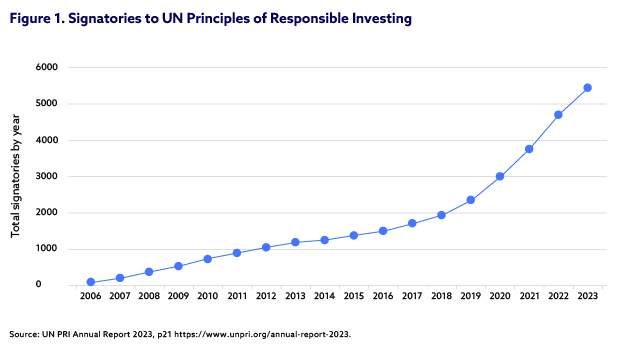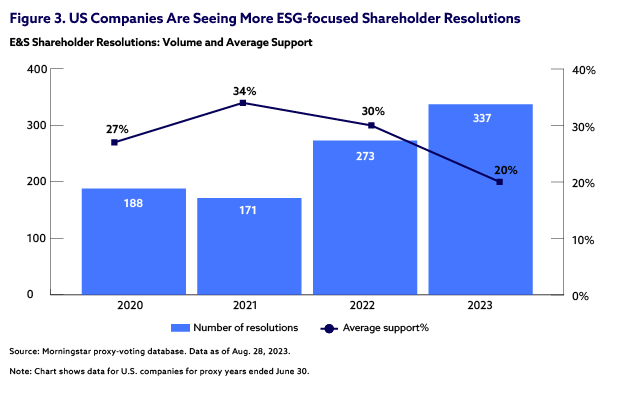CFA Institute
How Investors Achieve Impact Through Stewardship
Overview
The rise of responsible investment is changing how investors engage with companies over environmental and social factors.
Investors arguably always act as ‘stewards’ of the assets they own or manage – tasked with protecting and increasing their value over time. In recent years, the concept of investor stewardship has evolved to focus more on environmental and social factors as a driver of long-term value, in line with the growth of responsible investment practices.
As of March 2023, over 5,300 institutions have signed the UN Principles for Responsible Investment, which include a commitment to incorporate ESG issues into ownership policies and practices (See Figure1). Engagement activities have also risen, as investors look to translate their commitments into a positive environmental or social impact, as well as to increase the value of their portfolios.
Professional investment managers now need to ensure that their approach to engagement aligns with their clients’ stewardship mandates, as well as evolving statutory and regulatory requirements.
Balancing these priorities is a complex task that requires an understanding of stewardship expectations, market dynamics and the policy environment.

Why Stewardship Matters
CFA Institute, the Global Sustainable Investment Alliance (GSIA), and the Principles for Responsible Investment (PRI) have agreed on a common definition for stewardship: “the use of investor rights and influence to protect and enhance overall long-term value for clients and beneficiaries, including the common economic, social, and environmental assets on which their interests depend.
The focus on long-term value is why stewardship is particularly relevant to – and aligned with – the strategies of longer-term investors such as pension funds or sovereign wealth funds.
The rising prominence of investment stewardship is reflected in the establishment of stewardship codes across at least 20 jurisdictions, beginning with the UK in 2010 (See Figure 2). What’s more, there is a growing number of sustainability-related investment associations and networks – such as Climate Action 100+ and the Net Zero Asset Owners Association (NZAOA) – which often provide guidance on engagement expectations and processes.

Acting With Purpose
There are various ways that investors can put stewardship into action, including, most broadly, engagement with investees (and also with policymakers, standard setters and other stakeholders), and direct oversight of portfolio companies or assets.
Engagement typically takes place in private, but investors may decide to escalate the process if after a prolonged period they do not feel they have made sufficient progress. They may do so by taking more public measures, such as:
- Voting at shareholder meetings.
- Submitting shareholder resolutions or proposals:
- Nominating directors to the board or leveraging existing roles on the board or board committees – hedge fund Engine No 1’s success in winning three seats on energy giant ExxonMobil’s board in 2021 is a notable example.
In the most extreme cases, investors turn to litigation. There is a growing trend for them to put pressure on large corporates via the courts to drive the sustainability agenda, particularly on climate issues.
Engagement Activity
The scrutiny of how investors fulfil their stewardship obligations is evident in a number of trends.
- Pressure on passive investors: As passive investors increasingly dominate ownership of listed companies across the globe, they are under growing pressure to be active stewards. For instance, a July 2022 study estimated that passive investors held 37.8% of the US stock market. Big index asset firms like BlackRock, State Street and Vanguard therefore have huge clout over companies via shareholder voting rights.
- Increase in shareholder proposals: During the latest proxy season (the 12 months to 30 June 2023), investors voted on many more ESG-focused resolutions at US companies’ shareholder meetings, according to Morningstar (See Figure 3). However, investor support for these resolutions has declined, in line with a general pushback on ESG and increased scrutiny of investor voting practices.
- Investors offered more influence on voting: In recent years, the biggest asset managers have increasingly been offering investor clients pass-through voting – giving them a voice in how proxies are voted on the underlying equities, relative to the size of their shareholding – or the right to express voting wishes. BlackRock, DWS, Vanguard and State Street Global Advisors have all launched initiatives along these lines.
- Bondholders engaging to drive change: Some debt investors are recognizing that they are in a strong position to influence companies who rely on the bond markets for funding – they hold more sway than shareholders in that respect. Institutions such as Swedish pension fund Alecta and JP Morgan Asset Management have underlined this point.
- Increase in private equity investor engagement: There is growing pressure on investors in private equity and other private markets to use their close relationships with their portfolio companies to have a positive environmental or social impact.

Regulating Collaboration
When it comes to engagement, size matters. The larger the portion of asset or company – and the bigger the pool of assets in total – that an investor (or group of investors) holds, the greater the influence it wields.
Collective action on stewardship tends to both reduce the costs of taking action and increase the likelihood of success, according to the PRI. For instance, Engine No.1 would have likely failed in its resolution against ExxonMobil without the support of BlackRock, State Street and Vanguard.
There are, however, fears that collaboration on climate action can be viewed as anti-competitive behavior. This has led to challenges for institutional groups like Climate Action 100+ and the NZAOA. Policymakers in the EU and UK, among others, have made moves in 2023 to help ease such concerns.
What’s more, alongside the proliferation of stewardship codes, organizations such as the PRI want to see an effective regulatory framework for stewardship initiatives.
The trend for increased attention on stewardship and engagement efforts appears set to continue. How investors translate this growing scrutiny into action will, as ever, depend on individual circumstances, preferences and client objectives.


